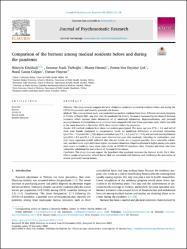| dc.contributor.author | Küçükali, Hüseyin | |
| dc.contributor.author | Türkoğlu, Sezanur Nazlı | |
| dc.contributor.author | Hasanlı, Shams | |
| dc.contributor.author | Dayanır Çok, Fatma Nur | |
| dc.contributor.author | Çulpan, Hazal Cansu | |
| dc.contributor.author | Hayran, Osman | |
| dc.date.accessioned | 2023-01-06T07:34:28Z | |
| dc.date.available | 2023-01-06T07:34:28Z | |
| dc.date.issued | 2023 | en_US |
| dc.identifier.citation | Küçükali, H., Türkoğlu, S. N., Hasanlı, S., Dayanır Çok, F. N., Çulpan, H. C. ve Hayran, O. (2023). Comparison of the burnout among medical residents before and during the pandemic. Journal of Psychosomatic Research, 165. https://dx.doi.org/10.1016/j.jpsychores.2022.111118 | en_US |
| dc.identifier.issn | 0022-3999 | |
| dc.identifier.issn | 1879-1360 | |
| dc.identifier.uri | https://dx.doi.org/10.1016/j.jpsychores.2022.111118 | |
| dc.identifier.uri | https://hdl.handle.net/20.500.12511/10252 | |
| dc.description.abstract | Objective: This study aims to compare the level of burnout syndrome in medical residents before and during the COVID-19 pandemic and identify potential risk factors. Methods: This cross-sectional study was conducted on medical residents from three different university hospitals in Turkey in March 2021, one year after the pandemic hit Turkey. Burnout is measured by the Maslach Burnout Inventory which assesses three dimensions of it: emotional exhaustion, depersonalization, and personal accomplishment. Collected data were combined and compared with data from a previous study which was held in the same hospitals in December 2019, three months before the pandemic. Results: 412 medical residents from three universities participated. The mean age was 27.8 ± 2.4 and half of them were female. Compared to pre-pandemic levels, no significant differences in emotional exhaustion (pre:19.0 ± 7.6 post:18.8 ± 7.8), depersonalization (pre:7.3 ± 4.3 post:7.2 ± 4.4), and personal accomplishment (pre:20.8 ± 5.1 post:21.1 ± 5) scores were observed one year after pandemic. Adjusting for confounders, multiple linear regression models indicated that who are female, are in surgical specialty, have vulnerable cohabitant, and have more night shifts faces higher emotional exhaustion. Depersonalisation is higher among who spent more years in residency, have more night shifts, or COVID-19 outpatient duty. Females and those who have vulnerable cohabitant has lower levels of Personal Achievement. Conclusion: This study does not support the hypothesis that pandemic increases the burnout levels. Yet it identifies a couple of pandemic related factors that are associated with burnout and confirming the association of several previously known factors. | en_US |
| dc.description.sponsorship | Abidin Fatih Emhan ; Ahmet Burak Börekçi ; Kadir Kolçak | en_US |
| dc.language.iso | eng | en_US |
| dc.publisher | Elsevier Inc. | en_US |
| dc.rights | info:eu-repo/semantics/openAccess | en_US |
| dc.rights | Attribution 4.0 International | * |
| dc.rights.uri | https://creativecommons.org/licenses/by/4.0/ | * |
| dc.subject | Burnout | en_US |
| dc.subject | COVID-19 | en_US |
| dc.subject | Mental Health | en_US |
| dc.subject | Resident Physician | en_US |
| dc.title | Comparison of the burnout among medical residents before and during the pandemic | en_US |
| dc.type | article | en_US |
| dc.relation.ispartof | Journal of Psychosomatic Research | en_US |
| dc.department | İstanbul Medipol Üniversitesi, Tıp Fakültesi, Dahili Tıp Bilimleri Bölümü, Halk Sağlığı Ana Bilim Dalı | en_US |
| dc.authorid | 0000-0003-1669-3107 | en_US |
| dc.authorid | 0000-0002-9994-5033 | en_US |
| dc.identifier.volume | 165 | en_US |
| dc.relation.publicationcategory | Makale - Uluslararası Hakemli Dergi - Kurum Öğretim Elemanı | en_US |
| dc.identifier.doi | 10.1016/j.jpsychores.2022.111118 | en_US |
| dc.institutionauthor | Küçükali, Hüseyin | |
| dc.institutionauthor | Hayran, Osman | |
| dc.identifier.wosquality | Q2 | en_US |
| dc.identifier.wos | 000974033300001 | en_US |
| dc.identifier.scopus | 2-s2.0-85144805689 | en_US |
| dc.identifier.pmid | 36565658 | en_US |
| dc.identifier.scopusquality | Q1 | en_US |



















